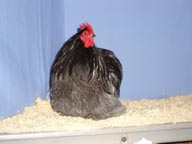Sample Breed Write Up
Cochins

Bryant Helvey's Blue Cochin
When initially introduced to North America around 1845, the Cochin’s progenitors were called Chinese Shanghai Fowl. Today’s Cochins differ from the first Shanghai imports in that they have extremely fluffy feathering, and fully feathered legs. The Shanghais that were imported had tighter feathering, resembling a modern New Hampshire, and they had either clean legs, or just a little feathering on their legs. But fanciers quickly took the fluffiest and most feathered-leg Shanghais and bred for those characteristics,developing a showy breed that became a sensation, attracting attention around the world, and causing the “Hen Craze”—a period when fanciers (ranging from Queen Victoria to backyard operators) began breeding birds for aesthetic traits and shows, instead of for production traits.
Modern Cochins are still quite showy. They are large birds, but thanks to their dense, long, and soft plumate, they look even more massive than they really are. The breed holds its head high, and has a unique cushion of feathers on its back and saddle that give it a distinctive curve from neck and shoulders to relatively short, pouffy tail.
Cochins are slow maturing birds, so most broiler operators aren’t interested in keeping them, but they do produce a respectable meat bird for barnyard and backyard operations. Cochins are friendly, docile birds that adapt to either confinement of free-range operations. They are quite hardy in cold climates. Hens lay most of the winter, brood readily, and are excellent mothers. They can be used as foster mothers for other breeds.
First Admitted to APA Standard of Perfection: 1874
Class: Standard Asiatic. Bantam Feather Legged
Size: Standard Cock—11 lbs; Hens—8.5 lbs; Bantam Cock—32 oz; Hens—28 oz.
Comb, wattles, earlobes: All are bright red. Male: Single comb, medium sized with five regularly spaced points that stands straight up, the middle of which is the longest. Well-rounded, long wattles and earlobes. Female: Single comb is quite small and rounded so as to conform to curve of head. Well-rounded, small wattles. Oblong earlobes.
Color: Beak is yellow to yellow shaded with black unless otherwise noted; eyes are reddish bay; shanks and toes are yellow.
Birchen Head is white to silvery-white. Standard birchen plumage.
Black Standard black plumage. Shank and outer toe feathers are black.
Black-tailed red Beak is reddish horn. Standard black-tailed red plumage. Shank and outer toe feathers are deep, lustrous red.
Blue Standard blue plumage. Shank and outer toes are blue.
Brown Beak is horn colored. Head is dark orangey red. Male: Hackle and saddle are the same color as head, or slightly more golden, but each feather has a black to greenish black stripe tapering to point at end of feather. Front of neck, breast, body, legs, shanks and outer toes, wings and tail, primarily black to greenish black though may be highlighted with golden bay. Female: Hackle is golden orange with black stripe in middle. Body is brown ranging from light to dark; feathers are stippled with black. Tail is black.
Brown red Standard brown red plumage. Shank and outer toe feathers same as legs.
Buff Standard buff plumage. Shank and outer toe feathers are light buff.
Buff Columbian Standard buff Columbian plumage. Shank and outer toe feathers are buff with black.
Columbian Standard Columbian plumage. Shank and outer toe feathers are white with black.
Golden Laced Beak is dark horn colored, shading to yellow at tip. Male: Head, neck, saddle are golden bay with black stripe down the middle. Cape is golden bay. Breast, body, wings, legs, shanks and outer toe feathers are golden bay with lacing of black. Tail primarily black. Female: Head is golden bay. Hackle is black with golden bay lacing and shaft. Rest of body is golden bay with black lacing. Main tail is black.
Lemon Blue Standard lemon blue plumage. Shanks and outer toes grayish blue.
Mottled Standard mottled plumage. Shanks and outer toes: 50% of feathers tipped with white.
Partridge Beak is dark horn colored, shading to yellow at tip. Standard partridge plumage. Shank and outer toe feathers in male are black, in females deep reddish bay penciled with black.
Red Beak is reddish horn. Overall deep lustrous red.
Silver laced Beak is dark horn colored, shading to yellow at tip. Male: Head, neck, and saddle are silvery white with black stripe down the middle. Cape is silvery white. Breast, body, wings, legs, shanks and outer toe feathers are silvery white with lacing of black. Tail primarily black. Female: Head is silvery white. Hackle is silvery white with a black stripe. Rest of body silvery white with black lacing. Main tail is black.
Silver penciled Standard silver penciled plumage. Shank and outer toe feathers are black in the male, and steel gray penciled in the female.
White Standard white plumage, including shank and outer toe feathers.
Place of origin: China
Special qualities: Large, attractive birds that are popular for showing. Good winter layers, and mothering abilities.